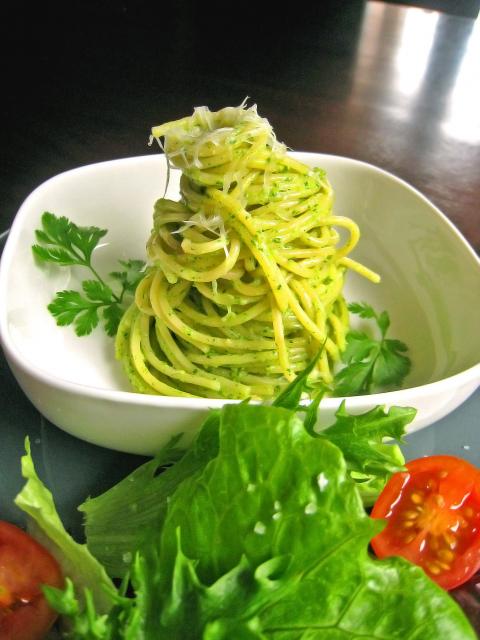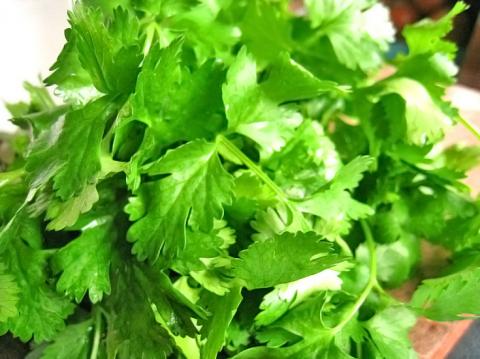Coriander is much used in Taiwan as a garnish and is available all year round. The winter months are when it thrives best, and these last months it has been a delight to see the delicate leaves bursting forth in odd corners of our vegetable patch. Freshly picked coriander leaves bring such lovely fragrance into the house and for me at least, never fail to enhance any dish they are used in.
Sadly, in Taiwan, this leafy green is often relegated to a similar role as parsley (it is in fact also know by the name Chinese parsley), doing no more than providing a splash of green to liven up the presentation of a dish. It rarely ever seems to have the chance to be the star.
One of the great beauties of coriander is its ease of cultivation. It is easy to keep some freshly picked leaves on hand even if you have nothing more than a window box. The homegrown leaves are so much more delicate and fragrant than those often found at the supermarket, all buffed up with fertilizer, their thick stems and big flabby leaves providing plenty of bulk but offering only a pale hint of coriander’s delights.

Photo: Ian Bartholomew
It is endlessly ironic that gastronomic enjoyment is often part of the high price we pay for year-round abundance.
Coriander in leaf form is often called cilantro in the US, a name derived from Spanish and which has taken root due to the extensive use of this herb in Mexican food. Closer to home, it is indispensable to Thai cuisine. The seed of the coriander plant is a key ingredient in all kinds of curries, and can be found in food from North Africa to India.
But long before the coriander in the veg patch run to seed, I have been diligently harvesting my own crop of leaves and putting them in all kinds of dishes. Even then, I often still have too much, and I usually use the excess to make my own version of pesto.

Photo: Ian Bartholomew
The most well-known form of pesto is that originating in Genoa in the Liguria region of northern Italy (pesto genovese), which uses basil, pine nuts and Parmesan cheese. Call it tunnel vision, but having focused on this version of pesto as the only “authentic” one, and finding that local basil (九成塔) was rather too acrid, and both pine nuts and cheese too costly for regular use, I had largely given up on this previously much-loved dish. It was only when rooting around for ways to use an over-abundance of coriander leaf that I discovered that there are many varieties of pesto, using different herbs, nuts and prepared both with and without cheese.
A coriander pesto is a great way of giving oneself a big dose of this lovely and healthful herb, which is also believed to have awesome powers of detoxification. Cilantro leaves have been found to have an antibacterial effect against salmonella and also help combat lead and other heavy metal toxicity. These functions have made it popular as an ingredient in “detoxifying” juices and drinks, but I have yet to find a beverage of this type that I have actually enjoyed.
Some people say that cilantro has a soapy taste, and no less a personage than culinary goddess Julia Child has pronounced it offensive in an interview with Larry King in 2002. There is even a Web site dedicated to disliking this herb (ihatecilantro.blogspot.com). The Oxford Companion to Food notes that the word “coriander” derives from the Greek word for bedbug, and that the smell of cilantro “has been compared with the smell of bug-infested bedclothes.” There is even a study, oft cited by coriander-haters, that dislike of the herb is genetic. Clearly, in countries where it is not a favorite, coriander faces a real battle for acceptance.
Well, perhaps it is an acquired taste. But for those not committed to a hatred of coriander, it is amenable to a wide variety of preparations, and can enhance all kinds of foods. It is certainly worth trying.
Coriander Leaf Pesto
Recipe (serves 4)
Ingredients
1 bunch of coriander (approx. 100g)
15g pumpkin seeds
15g blanched almonds
1 clove garlic, peeled
1 small chili, minced (seeds removed)
Pinch of coarse sea salt
Ground pepper
Olive oil
Directions
1. Put the coarse sea salt and garlic in a mortar and pound into a smooth paste.
2. Wash the coriander and remove the stems. Add the coriander leaves to the mortar and pound until the leaves begin to disintegrate.
3. Add the pumpkin seeds and almonds. You can pound more or less depending on preference, anywhere from a smooth paste to something akin to chunky peanut butter. (Using a blender will get you a paste very quickly, but if you like it a bit chunky, doing it by hand produces a much nicer texture.)
4. Gradually add olive oil and mix until you have a loose paste. Add the minced chili and some pepper to taste.
5. Serve with pasta or simply spread it on toast or incorporate it into sandwiches.

Desperate dads meet in car parks to exchange packets; exhausted parents slip it into their kids’ drinks; families wait months for prescriptions buy it “off label.” But is it worth the risk? “The first time I gave him a gummy, I thought, ‘Oh my God, have I killed him?’ He just passed out in front of the TV. That never happens.” Jen remembers giving her son, David, six, melatonin to help him sleep. She got them from a friend, a pediatrician who gave them to her own child. “It was sort of hilarious. She had half a tub of gummies,

June 23 to June 29 After capturing the walled city of Hsinchu on June 22, 1895, the Japanese hoped to quickly push south and seize control of Taiwan’s entire west coast — but their advance was stalled for more than a month. Not only did local Hakka fighters continue to cause them headaches, resistance forces even attempted to retake the city three times. “We had planned to occupy Anping (Tainan) and Takao (Kaohsiung) as soon as possible, but ever since we took Hsinchu, nearby bandits proclaiming to be ‘righteous people’ (義民) have been destroying train tracks and electrical cables, and gathering in villages

The wide-screen spectacle of Formula One gets a gleaming, rip-roaring workout in Joseph Kosinski’s F1, a fine-tuned machine of a movie that, in its most riveting racing scenes, approaches a kind of high-speed splendor. Kosinski, who last endeavored to put moviegoers in the seat of a fighter jet in Top Gun: Maverick, has moved to the open cockpits of Formula One with much the same affection, if not outright need, for speed. A lot of the same team is back. Jerry Bruckheimer produces. Ehren Kruger, a co-writer on Maverick, takes sole credit here. Hans Zimmer, a co-composer previously, supplies the thumping

Swooping low over the banks of a Nile River tributary, an aid flight run by retired American military officers released a stream of food-stuffed sacks over a town emptied by fighting in South Sudan, a country wracked by conflict. Last week’s air drop was the latest in a controversial development — private contracting firms led by former US intelligence officers and military veterans delivering aid to some of the world’s deadliest conflict zones, in operations organized with governments that are combatants in the conflicts. The moves are roiling the global aid community, which warns of a more militarized, politicized and profit-seeking trend